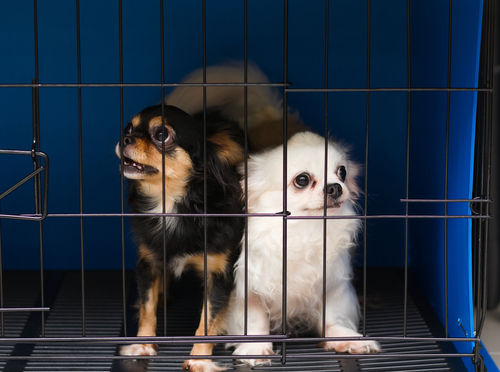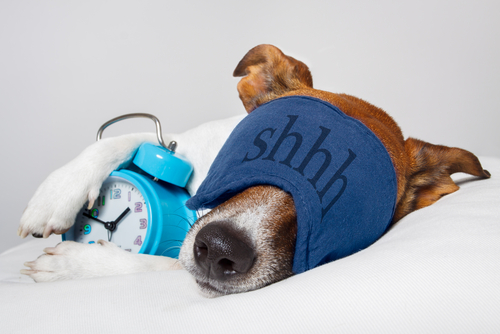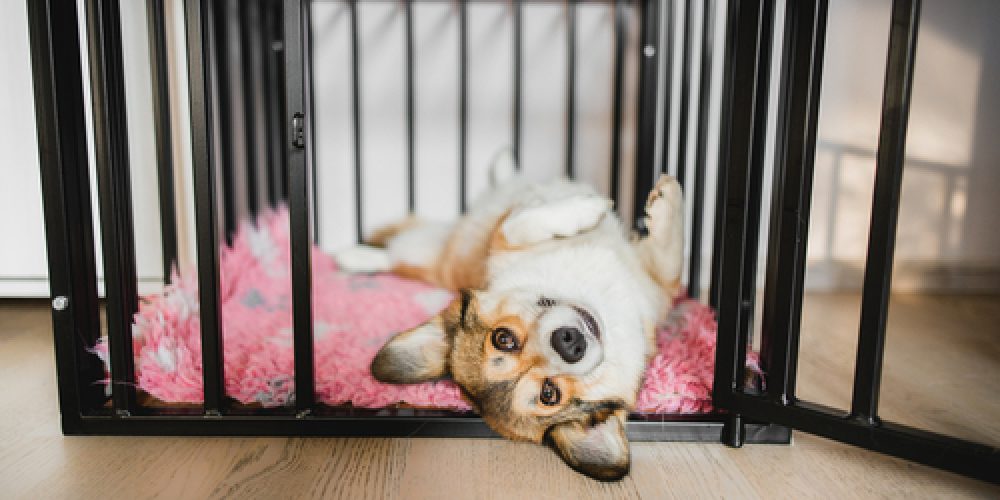Introduction to crate training
Always remember that crate training is a gradual process, and each dog may respond differently.
Start by…
Looking into the benefits:
- A great way to help your dog relax and get used to having their own calm space and time. Undisturbed sleep and rest are proven to help reduce stress and anxiety.
- Provides a safe place to hide and retreat to help separation issues and other behaviour issues such as noise fears.
- Also great for travelling, when away on holiday or in a different environment.
- Helpful if your dog needs to be confined after an illness or operation.
Choosing the right crate:
- Appropriate crate size for your dog.
- Selecting the right material (metal, plastic, or soft-sided).
Setting up the crate:
- Choose the ideal location in your home.
- Choose a quiet area where they won’t be disturbed when resting or sleeping. Ideally away from the front door or windows if this triggers them.
- Put their favourite bedding, toys and treats inside.
- Use long-lasting chew toys such as food stuffed Kongs and Lick mats to get them used to settling in the crate.
- Make sure to provide fresh water at all times.
Introduction to the training process:
- Gradual introduction to the crate.
- Using positive reinforcement techniques.
Getting started:
- Allow your dog to explore the crate freely while leaving the door open.
- Encourage short periods of time inside with treats with the door closed.
Increasing crate time:
- Gradually extend the time spent in the crate: provide a long-lasting chew toy with you present, for example, you could sit and read a book nearby.
- Work towards them settling for periods on their own when you are at home in sight, then in another room, then when you are out.
Mealtime in the crate:
- Feed your dog in the crate to create positive associations.
- Build a routine around mealtime and the crate.
Crate as a positive area:
- Reward calm behaviour with treats and praise.
- Train a positive cue when they go in the crate such as ‘in your bed’ and reward them with a favourite treat. This will teach them to go in the crate on cue and help them associate this with a positive space.
Troubleshooting and tips for success with crate training
Common challenges:
- Dealing with whining or barking
- Addressing anxiety or fear
If they show any signs of stress or anxiety go back a step in the training process.

Dealing with whining or barking
Whining or barking can be common behaviours exhibited by dogs during the crate training process. Understanding how to address and manage these challenges is crucial for a successful training experience.
- Identify the cause:
- Determine if your dog is whining or barking due to anxiety, fear, or simple protest against being confined.
- Observing your dog’s body language can provide insights into the underlying cause.
- Avoid punishment:
- Never scold or punish your dog for vocalising in the crate. This can create negative associations with the crate.
- Instead, focus on positive reinforcement for calm behaviour.
- Try to ignore barking/whining and reward calm, quiet behaviour instead.
- Gradual acclimatisation:
- Increase crate time gradually to allow your dog to get used to the space.
- Start with short intervals and extend them as your dog becomes more comfortable.
- Use distraction techniques:
- Provide interactive toys or treat-filled puzzles to keep your dog occupied in the crate.
- This can redirect their focus and reduce whining or barking.
- Calming signals:
- Use calming signals, such as a soothing voice or gentle petting, when your dog appears anxious.
- Establish a calm environment around the crate to reduce stress. This can be done by covering the top and sides with a blanket to make it into a cosy den or/and plug a calming Adaptil diffuser nearby.

Addressing anxiety or fear
Anxiety and fear can hinder the crate training process. Taking steps to alleviate these emotions will help create a positive association with the crate.
- Create a safe haven:
- Make the crate a comfortable and inviting space by adding familiar blankets and toys.
- Associate the crate with positive experiences, like treats and praise.
- Desensitisation techniques:
- Gradually expose your dog to the crate without closing the door initially.
- Reward positive behaviours and gradually increase the time of confinement.
- Establish a routine:
- Dogs thrive on routine, so establish a consistent schedule for crate time, meals, and walks.
- Predictability helps reduce anxiety as your dog knows what to expect.
- Calming aids:
- Consider using calming aids such as pheromone sprays (Adaptil diffuser) or calming music designed for dogs.
- Cover the top and sides with a blanket to make it into a cosy den.
- These can create a soothing environment and ease anxiety.
- Professional help:
- If anxiety or fear persists, consider seeking guidance from a registered animal behaviourist.
- They can provide tailored strategies to address specific issues and enhance the training process.
Avoiding mistakes:
- Never use the crate as a form of punishment.
- Avoid prolonged confinement.
Tips for success:
- Consistency is key: stick to a routine.
- Patience and positive reinforcement go a long way.
Gradual independence:
- Introduce longer periods of alone time in the crate slowly.
- Transition from leaving the crate door open to closed when you’re home.
By following this comprehensive guide, you’ll not only successfully crate train your dog but also strengthen the bond between you and your furry friend. Remember, patience and consistency are the keys to a happy and calm canine companion.

If you have any concerns about your dog or need help, Joii is here. Download the app and speak to one of our vets now, who can also refer you to our behaviourist.











